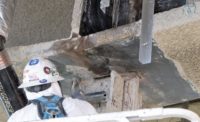The steel fabricator for the third-floor tapered, built-up plate girders at the troubled Salesforce Transit Center in San Francisco is calling for a girder-hanger connection design review as part of the probe into the causes of brittle fractures in bottom flanges of twin 80-ft-long members that bridge Fremont Street. The facility was closed in late September.
At the midspan, each 8-ft-deep girder web is thickened by a vertical hanger plate to support the second-floor bus deck below. The hanger plate is welded to the web and slots through the girder’s bottom flange.
“I believe the hanger detail is the largest contributing factor to the problem,” says Robert Hazleton, president of fabricator The Herrick Corp. “We have been assured that a thorough review of the hanger design is part of the investigation.”
Mark Zabaneh, executive director for the owner, Transbay Joint Powers Authority (TJPA), says, "we are all very eager to determine the cause of the [fractures] discovered on two [girders] at the transit center at Fremont Street, repair the girders and safely reopen the transit center. We are weighing all of the facts as we go about determining how and why this happened and have not ruled out design, fabrication or installation. We are fully investigating this incident as well as cooperating with the independent analysis" being provided by experts from the Metropolitan Transportation Commission’s design review panel."
The twin girders are much like bridges in that they hang a bus deck and span a street. The girders’ hanger connection detail would normally not be used in modern bridge construction, says a structural engineer familiar with the design. The hanger could have been framed around—not through—the flange and connected with bolts to the web using plates framing into the web, says the bridge expert, who declines to be identified.
A double hanger detail would have avoided cutting a hanger slot into the 4-in.-thick flange. The existing slot intersects the butt-weld joint in the flange at the girders’ midspans, where there are maximum flexural stresses, says the expert.
The connection of the hanger plate to the web also produces a “very poor fatigue detail” at the end of the web-to-hanger butt weld, adds the engineer. Further, the connection detail used, with a weld hole added during the shop-drawing phase, is not covered in the bridge specification.
Bruce Gibbons, a managing principal of transit center structural engineer Thornton Tomasetti (TT), declined to comment on the connection until after the investigation is complete.
Herrick’s concerns are a response to a Dec. 13 public presentation to TJPA’s board of directors by engineer Robert S. Vecchio, CEO of LPI, the metallurgist investigating the brittle fractures.
According to Vecchio, analyses and testing performed to date “suggest the probable cause of the girder fractures is the formation of cracks in the girder weld-access-hole radii prior to service.” LPI’s client is TJPA through TT and Turner Construction Co., the facility’s construction manager, according to Vecchio.
Shallow surface micro cracks developed during “thermal cutting of the weld access holes in the highly hardened and brittle martensitic surface layer,” said Vecchio. Then, larger pop-in cracks formed in two of the four flanges, potentially during the butt-welding of flange plates.
“Rapid low-energy fracture of the flanges occurred as the girder was subjected to service loading, on top of the normal stresses due to fabrication,” said Vecchio. Material testing and finite-element stress analyses underway will be considered in the final root-cause assessment expected next month, he added.
Hazleton says the 2-in. by 4-in. flange holes on either side of the web are not weld access holes, based on their size, shape and flange location. WAHs would have been 2 in. by 12 in.
“They were not required to access a weld and not ground or subjected to nondestructive testing because they are not [WAHs],” he says.
The American Institute of Steel Construction concurs. WAHs are specifically applicable “only to the profile of the web” in a built-up I-shape and “provided to allow access to make the weld of the adjacent flange continuous past the interfering web,” says Lawrence F. Kruth, AISC’s vice president of engineering.
Gibbons disagrees. The holes in the Fremont Street flanges were proposed as a result of a request for information by the steel subcontractor, Skanska USA Civil West, “for the purpose of executing the welding of the girders,” he says. “In that RFI, the holes were described as weld access holes by both the steel subcontractor and engineer. … No concerns … regarding the suitability of this detail were raised by the steel subcontractor at the time,” he adds.
At the TJPA meeting, Gibbons proposed a girder fix. The bolt-only repair would bypass fractured flanges by sandwiching them, on both sides of the web, between 14-ft-long steel splints.







Post a comment to this article
Report Abusive Comment